Ask someone to picture a child’s first riding lesson and they’ll usually imagine something like this: a little rider climbing into the saddle, trotting off with a smile, and maybe even learning to steer a bit before the hour is up.
But if you’ve ever taught real beginners—especially children—you know the first lesson is something else entirely. Yes, there might be riding. But the lesson is really about the horse.
And that’s how it should be.
It’s Not Just About Riding—It’s About Meeting the Horse
When a new student—especially a young one—comes to their first lesson, they’re not just learning how to sit in the saddle. They’re being introduced to a whole new world:
-
- What a horse is like up close
-
- How to stay safe around a 1,000-pound animal (maybe 600 pounds if it’s a pony — but still…)
-
- What to do with strange-looking tools and unfamiliar tack
-
- How to listen, observe, and build confidence step by step
- How to remember everything the teacher says
For many students, this is their first time seeing a hoof, holding a lead rope, or standing next to something that breathes and blinks and towers over them. That matters.
The Power of Groundwork
In my barn, students often groom and help tack up their horses as part of their lesson. I’ve found this gives them a chance to build familiarity and trust before they ever mount. It also gives me a window into how they learn—whether they’re tentative or bold, whether they ask questions or need help finding their rhythm.
There’s a lot to take in during that first hour. Haltering. Leading. Standing in the right place. Learning not to walk behind the horse. Recognizing how a horse communicates.
I always tell my students, “I’m going to teach you more than you’ll remember today, and that’s okay. You’re not supposed to remember everything yet—we’ll go over it together again and again until you do.”
That one sentence can ease a lot of anxiety—for kids and their parents.
A Taste of Riding
Yes, most of my first lessons include some time in the saddle. But riding isn’t the only goal. The student is learning how to get on correctly. How to sit with balance. How to say “walk on” and get a response. How to hold the reins and feel the movement of a horse beneath them.
That short time in the saddle is where it all comes together: the horse they helped prepare now becomes their partner in motion. It’s the “aha” moment. But it only lands well because we’ve built the foundation first.
What Students Really Learn
By the end of the first lesson, the student may not remember every term or step. But they’ve:
-
- Learned how to be safe
-
- Gained confidence being near a horse
-
- Been introduced to basic tools and tack
-
- Started using real riding language
-
- Gotten a feel for what’s to come
Most of all, they’ve taken their first step toward becoming horsemen and horsewomen—not just passengers.
Final Note to Instructors
The first lesson isn’t about performance. It’s about orientation, safety, and planting the seeds for a long-term relationship with horses. Don’t worry if it’s slow. Don’t worry if it doesn’t look like much from the outside. You’re laying the groundwork for everything that comes next.
Keep teaching riding. You make a difference.
Barbara Ellin Fox

Thank you for this important thread on our fragile beginners, the foundation of our future
Thank you, Kathryn. You are so right, beginners are the future. Without a steady influx of new riders, our industry and riding world would eventually fail. And if we don’t teach the solid basic foundation, good riding will be lost. Thanks for your comment. Babrara
I do a from the ground up horsemanship program. First lesson is about getting the horse/pony safely, leading it to the grooming area, grooming, and some times we make it to tacking up within the hour. All beginners are started with private lessons on a lunge-line. Safety is my biggest concern as well as the long term health of the lesson mounts. Many of the programs here, the horses are led into the arena by a groom, student gets on, does their lesson, horse is taken back to the mounting block, student dismounts and groom takes the mount away. I know they do this for insurance reasons, but . . .
Hi Kathy I love a program that teaches from the ground up. It’s so great for the students and even better for the horses because the student learns to handle them kindly. A horsemanship based program is for the horse and the rider. A riding only program is for the rider without the same benefit for the horse. As much as I’d like to see everyone learn how to care for the animal, I think about the young people who go on vacation and ride, or ride a friend’s horse, and I’m glad they learned at least that much. I guess what I can’t abide are programs that don’t teach helmet safety (I know you require them) Thanks for your interesting comment. Barbara